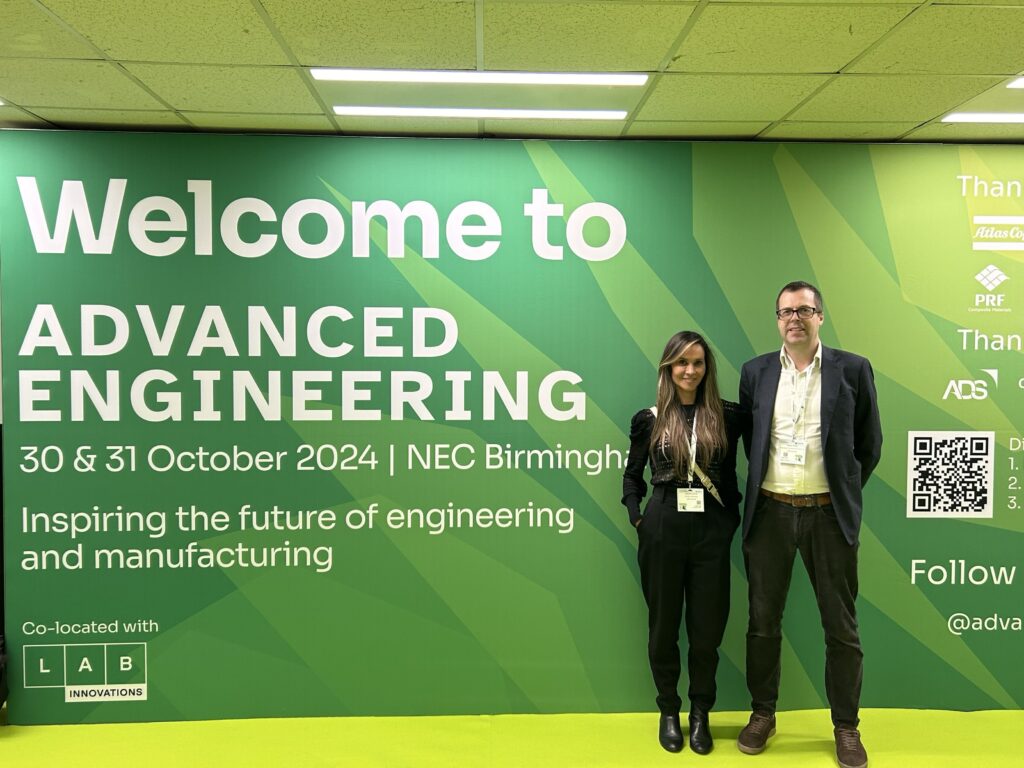A few weeks ago, my colleague Amanda and I were among the thousands wandering the halls of the NEC in Birmingham, for the 2024 edition of the Advanced Engineering exhibition. This inspiring showcase of cutting-edge technology and innovation attracts exhibitors across multiple sectors, from aerospace and automotive to green energy and manufacturing. Key themes and topics this year included AI, automation, efficiency, quality, safety and sustainability.
Lightweight, and lightning fast
One of the exhibition’s central themes was the development of advanced materials, particularly lightweight composites and bio-based polymers. These materials are designed for high performance, often exceeding the strength and durability of traditional options while significantly reducing weight. For industries like aerospace and automotive, where weight reduction translates directly into fuel savings, these materials offer crucial, tangible environmental and economic benefits. Exhibitors showcased applications of these materials in various forms, such as carbon-fiber components, which enhance structural integrity and performance without the added weight.
Besides fuel savings, lightweight composites also offer an ideal solutions when you’re building something that needs to go fast. Multiple examples of aerospace and motor sport applications were on display – and one very fast boat! Exhibitor PRF Composites highlighted its involvement with the ThrustWSH project, attempting to break the world water speed record of 317mph, which has stood for more than four decades.
Print on demand
Additive manufacturing, or 3D printing, was another area that drew significant attention. The exhibition demonstrated how this technology is revolutionising production by enabling rapid prototyping, customisation, and on-demand manufacturing. Unlike traditional manufacturing processes, which can be material-intensive and generate significant waste, additive manufacturing builds parts layer-by-layer, using only the necessary amount of material. This method not only minimises waste but also enables companies to create complex geometries that would be impossible to produce using conventional means. Several exhibitors highlighted how additive manufacturing can streamline the supply chain by producing components closer to the point of use, reducing the need for long-distance shipping and further supporting sustainability goals.
Putting it to the test
Quality inspection, testing and evaluation was also a prominent theme, with our own client Fujifilm NDT, showcasing the latest digital and computed radiography methods of non-destructive testing (NDT). NDT allows inspection, measurement, and testing of materials and systems without causing any damage or disruption. Ultra-high resolution x-ray imaging delivers precision and clarity, ensuring that potential issues can be addressed before they become problems and that faults are identified so that maintenance or repairs can be carried out, avoiding the worst case scenario of sudden, catastrophic machinery failure.
Elsewhere on the show floor, quality inspection company Keyence showed us their digital microscopes for detailed inspection. The zoom of up to 6,000x (down to 210nanometers) was impressive enough, but on top of this, the microscope can also rotate, so as well as seeing every detail in extraordinary detail, you can also see the object from every angle.
Sustainable innovation
Sustainability in manufacturing was a major focus, with particular attention on circular economy principles. Companies are increasingly designing products with end-of-life considerations, ensuring materials can be reused or recycled rather than discarded. Exhibitors highlighted closed-loop systems, where waste materials from one process are repurposed as inputs for another. These systems, when combined with automation and IoT technology, enable real-time tracking of material use and waste, optimising resource consumption. This shift towards a circular economy model represents a broader trend across industries, reflecting a change in how companies approach production and waste, aiming to build systems that are both economically and environmentally sustainable.
Overall, Advanced Engineering this year offered fascinating insight into the close relationship between innovation, safety and sustainability. As industries face increasing pressure to reduce environmental impact, the event provided a glimpse into how emerging technologies can support these goals, while at the same time improving product quality, efficiency, performance and safety.
